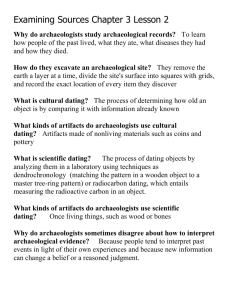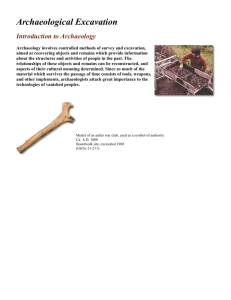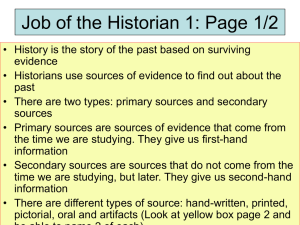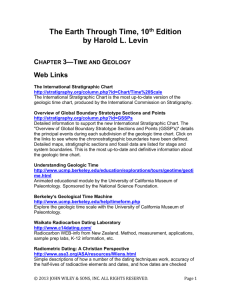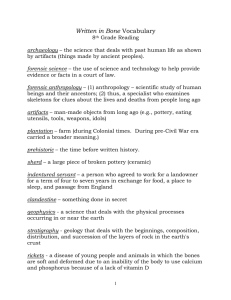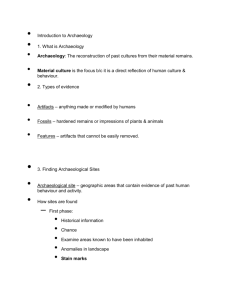relative dating in archeology 1
advertisement
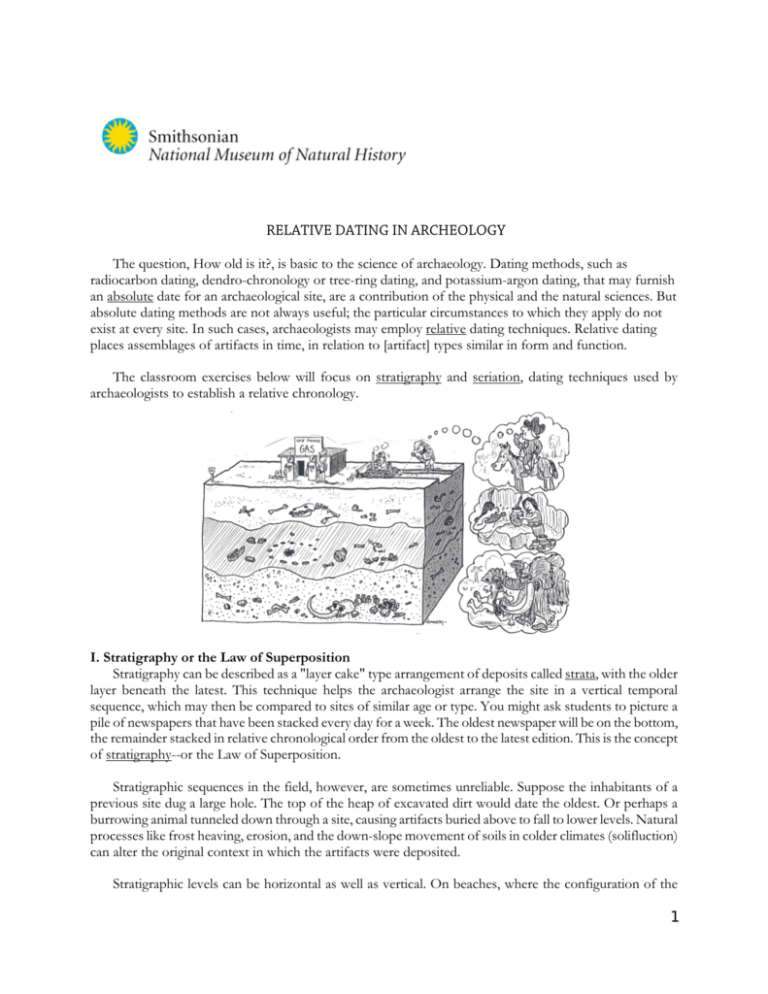
RELATIVE DATING IN ARCHEOLOGY The question, How old is it?, is basic to the science of archaeology. Dating methods, such as radiocarbon dating, dendro-chronology or tree-ring dating, and potassium-argon dating, that may furnish an absolute date for an archaeological site, are a contribution of the physical and the natural sciences. But absolute dating methods are not always useful; the particular circumstances to which they apply do not exist at every site. In such cases, archaeologists may employ relative dating techniques. Relative dating places assemblages of artifacts in time, in relation to [artifact] types similar in form and function. The classroom exercises below will focus on stratigraphy and seriation, dating techniques used by archaeologists to establish a relative chronology. I. Stratigraphy or the Law of Superposition Stratigraphy can be described as a "layer cake" type arrangement of deposits called strata, with the older layer beneath the latest. This technique helps the archaeologist arrange the site in a vertical temporal sequence, which may then be compared to sites of similar age or type. You might ask students to picture a pile of newspapers that have been stacked every day for a week. The oldest newspaper will be on the bottom, the remainder stacked in relative chronological order from the oldest to the latest edition. This is the concept of stratigraphy--or the Law of Superposition. Stratigraphic sequences in the field, however, are sometimes unreliable. Suppose the inhabitants of a previous site dug a large hole. The top of the heap of excavated dirt would date the oldest. Or perhaps a burrowing animal tunneled down through a site, causing artifacts buried above to fall to lower levels. Natural processes like frost heaving, erosion, and the down-slope movement of soils in colder climates (solifluction) can alter the original context in which the artifacts were deposited. Stratigraphic levels can be horizontal as well as vertical. On beaches, where the configuration of the 1 shoreline has changed through time, the earliest site may be inland, the later site closest to shore. The stratigraphic levels would then be spatially horizontal, conforming to the changing coastline. Horizontal stratigraphy may also occur when a later culture settles next to an earlier abandoned site, thereby appearing to be contemporary to the older site. Despite problems of interpretation, stratigraphy is a powerful archaeological tool in unlocking the mysteries of past lifeways. Exercises 1. Ask the students to think of ways that the vertical sequence of newspapers could be disturbed. (If the newspapers were not dated, the chronological sequence could probably still be deduced from their content.) 2. Using the example of the stack of newspapers, ask the students how they might apply relative dating using the concept of horizontal stratigraphy. 3. There are many possibilities for a theoretical sequence, once the students are familiar with the material culture and history of groups inhabiting the United States at various times. Better yet, use the chronology developed for your local area. The students may then generate a "time line," interpreting the ways in which past peoples may have used the artifacts at their disposal in their daily lives. Have your class develop a poster showing a theoretical stratigraphic deposit, or archeological sequence. Then ask them to analyze the cultural materials to deduce what the lives of the people of that time were like. Below is an example of a possible sequence that could be illustrated on a poster. Level I (earliest): pictures of fire blackened rocks in a rough circle suggesting a hearth; scattered stone tools; and scattered animal bones and fruit pits. These artifacts suggest a people who hunt and gather for a living; who own few material possessions, suggesting mobility; and who have mastered the use of fire and tool making. Level II (middle): pictures of sherds (broken pieces) of decorated pottery; a mortar and pestle for grinding grain; scattered beads and carved figures; post holes (shown as a regularly patterned darkened areas of soil) for a dwelling; scattered bones of wild game. These artifacts suggest people who are settled, at least part of the time. They make pottery, which is not easily portable, as well as decorative items. They have access to a regular food source, as the grinding equipment shows, but probably still also hunt for wild game. Level III (latest): pictures of a pipe stem (which can be assigned a date of 1794 by its diameter); a coin dated 1802; a bullet casing; a few grains of corn; the skeletal remains of a horse; a metal coffee pot lid. What can be said of these people? What cannot be inferred from this level? The coin is significant because it provides the earliest potential date of the site. The coin was made in 1802, but could have been dropped any time after that date, as the pipe stem must have been dropped later than its date of manufacture. This concept called the terminus post quem (the date after which) is of particular importance to archaeologists dealing with the historic period. Your local archeologist may be able to furnish suitable materials, or the sequences in the publications listed below may be used for illustration. The time line generated by your students will introduce them to the important concept of stratigraphy, as well as to the goal of archaeology: to reconstruct past lifeways and place them in a chronological framework in order to better understand the present. 4. Archaeologists may date deposits on the basis of the newest artifact found in the level. To illustrate this concept, collect a handful of coins of varying dates. Which is the oldest? Which is the latest? If they were all buried together, what date could be placed on the level in which they were found? The answer is that we can only say that the coins were deposited sometime after the date of the newest coin. 5. For younger students, the concept of stratigraphy may be reinforced by gluing the pictures of artifacts to 2 cardboard and cutting them up as one would make a puzzle. These could then be scattered over layers made of crumbled tissue paper, to be "excavated" and "mapped" in levels by the class. A grid of rubber bands or string may be placed over the "site" to aid in the accurate mapping of the artifacts. Students may be divided into teams of excavators and mappers with as many "sites" as feasible. The students then could make a time line based on the interpretation of their finds. II. Seriation When a stratigraphic sequence is lacking, another relative dating technique known as seriation may be applied. This technique dates a site based on the relative frequency of types of artifacts whose dates of use or manufacture are known. The basic assumption underlying seriation is that the popularity of culturally produced items [such as clay pipes or obelisk gravestone markers in America] varies through time, with a frequency pattern that has been called the "battleship curve." An item is introduced, it grows in popularity, then its use begins to wane as it is replaced by another form. Certain types of artifacts have been identified as particularly useful temporal markers, for example, gravestones, projectile points, lamps, pottery sherds. Before being able to interpret materials found at a site, an archaeologist faces the task of sorting the artifacts into manageable units for analysis. This is frequently a difficult task. Sorting is usually based on form and function. What does it look like? What is it made of? Is it decorated in any way? Have you ever seen it before? Exercises 1. To acquaint your students with the problems faced by archaeologists in determining the form and use of an object, ask each one to bring in an unusual item or two, whose function may not be well known. Possible objects are: old kitchen implements, personal items [shaving brush, buttonhook], parts of toys, travel souvenirs, and natural objects such as unusual rocks. Ask the students to exchange their items with others in the class to guess their use. Then ask the students to arrange them in sets according to distinctive characteristics. The kinds of questions they should ask are: Is it made of wood, paper, cloth, metal, pottery? Is it large or small? Is it for personal care, decoration, or amusement, or does it have a utilitarian purpose? How was it made? Were the materials used in its manufacture from the local area or from far away? Where was the object itself made? How did it get here? Who made it, a specialized craftsman or an ordinary member of the society? The categories for classification will be suggested by the objects in the assemblage. Are there any patterns apparent in the objects the students have brought to class? Is any item of a greater frequency? 2. Ask the students what they can deduce about the people who use the objects. This exercise will introduce students to the concept of deducing the lifeways of people from the artifacts of material culture, which were used in everyday activities. This article, by Cathy Griggs, formerly of George Washington University, first appeared in AnthroNotes vol. 10, no. 3, fall 1988. Illustration © by Robert L. Humphrey estate. (For more information on archaeological methods and sites, request the leaflet “Archaeology” for additional resources from anthroutreach@si.edu) 3



